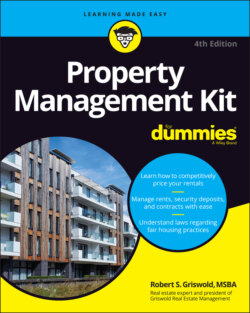Читать книгу Property Management Kit For Dummies - Robert S. Griswold - Страница 16
Examining Types of Real Estate
ОглавлениеBefore you run out to purchase a residential rental property, you need to have a good idea of the different types you can own. Most real estate investors specialize in properties with specific uses. Investment properties fall into classifications such as residential, commercial, industrial, hospitality, and retail.
For the purposes of this book, I focus only on residential real estate because the majority of rental real estate is housing, and the basic concepts are easy to understand and master. (After you master the basic concepts of residential real estate, you may want to consider other types of property management.) The best practices I present throughout this book are applicable to these types of residential rental properties:
Single-family houses and condominiums or townhomes: Most real estate investors start with a rental home, condo, or townhome because these properties are generally the easiest ones to gain experience with. They may be located in a common interest development (CID) or community association in which all the common areas are the association’s responsibility.
Duplexes, triplexes, and fourplexes or subdivided houses: This category includes properties with two to four units. Often, these properties are the first choice for real estate investors who plan to live in one of the units or want to take the next step up from investing in a single-family rental home or condo. These properties qualify for favorable financing terms, so they’re perfect for the new investor or an investor in higher-priced urban markets.
Medium-size multifamily apartment buildings: These buildings usually have between 5 and 30 units; they are best run with part-time to full-time on-site management and regularly scheduled maintenance and contractor visits.
Large multifamily apartment buildings: These properties are larger buildings that can have 30 or more rental units in a single location, or in close proximity on scattered sites, with an on-site manager or maintenance staff. Owning one of these properties is the goal of many real estate investors who look forward to being able to hire a professional property manager and just check their bank account for their regular cash distributions. (In Chapter 3, I reveal what to look for in a good professional property manager.)
No matter what type of residential real estate you’re involved with, you need to understand the basics of property management. You must market or staff a property differently depending on its size and location, but many of the fundamentals are the same regardless.
Over the course of your tenure as a property manager, you’ll probably manage several types of residential properties, which is just one of the challenging yet fulfilling aspects of the job. You may start out managing single-family rental homes or condos, for example, and then see your investments or career progress to larger rental properties. Sometimes, people in the rental housing business start as on-site employees for large rental properties, learn the ropes, and later apply that knowledge to become market dominators of rental houses in their areas.
Owning and managing all types of rental property can be lucrative, so I suggest that you jump in wherever you have your first opportunity, because no rules mandate your starting position.
